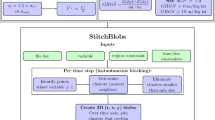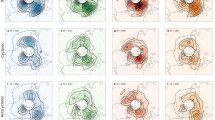Abstract
Typical blocking indices in longitude or both longitude and latitude are compared to demonstrate: (1) the central blocking latitude (CBL) should be any of 40–80° N; (2) reversals of meridional gradients in absolute fields (ABS) about specified CBLs or in combination with time anomalies exceeding a threshold missed blocking patterns or misidentified non-blocking structures. Blocking highs are identified by a new Eddy-ABS index. A large-scale high is represented by a local maximum of zonal eddy anomalies, its immediately surrounding points and subsequent contiguous grids with decreasing anomalies but exceeding the 75th percentile. A high with any ABS reversal is an instantaneous blocking (IB). Maximum overlapping IBs become quasi-stationary when moving less than 10° longitudes per day. Four and more quasi-stationary IBs form a blocking event (BE). This unified index has identified IBs and BEs at vertical levels in the Northern (NH) and Southern Hemispheres (SH) during different seasons. In the NH, BEs exhibit strong seasonality, geographical preference and quasi-barotropicity. The lifetime, maximum intensity, impact area, and moving speed have a log-linear, log-normal, log-normal, and normal distribution, respectively. These features occur similarly in the SH, except for very small occurrences at 200 hPa in JJA and a normal distribution for the maximum intensity. Properties other than the moving speed significantly correlate with the maximum intensity in both hemispheres. The missing and misidentification issues are reasonably well resolved by this new index.
















Similar content being viewed by others
Notes
Select grids at Z850 have climatological surface pressures not smaller than 850 hPa.
References
Barriopedro D, Garcia-Herrera R, Lupo AR, Hernandez E (2006) A climatology of Northern Hemisphere blocking. J Clim 19:1042–1063
Barriopedro D, Garcia-Herrera R, Gonzalez-Rouco JF, Trigo RM (2010) Application of blocking diagnosis methods to general circulation models. Part I: a novel detection. Clim Dyn 35:1373–1391
Brunner L, Hegerl GC, Steiner AK (2017) Connecting atmospheric blocking to European temperature extremes in spring. J Clim 30:585–594
Carrera ML, Higgins RW, Kousky VE (2004) Downstream weather impacts associated with atmospheric blocking over Northeast Pacific. J Clim 17:4823–4839
Colucci SJ, Kelleher ME (2015) Diagnostic comparison of tropospheric blocking events with and without sudden stratospheric warming. J Atmos Sci 72:2227–2240
D’Andrea F, Tibaldi S, Blackburn M, Boer G, Déqué M, Dix MR, Dugas B, Ferranti L, Iwasaki T, Kitoh A, Pope V, Randall D, Roeckner E, Straus D, Stern W, Van den Dool H, Williamson D (1998) Northern Hemisphere atmospheric blocking as simulated by 15 atmospheric general circulation models in the period 1979–1988. Clim Dyn 14:385–407
Davini P, Cagnazzo C, Gualdi S, Navarra A (2012) Bidimensional diagnostics, variability, and trends of Northern Hemisphere blocking. J Clim 25:6496–6509
Davini P, Cagnazzo C, Fogli PG, Manzini E, Gualdi S, Navarra A (2014) European blocking and Atlantic jet stream variability in the NCEP/NCAR reanalysis and the CMCC-CMS climate model. Clim Dyn 43:71–85
Diao Y, Li J, Luo D (2006) A new blocking index and its application: blocking action in the Northern Hemisphere. J Clim 19:4819–4839
Doblas-Reyes FJ, Casado MJ, Pastor MA (2002) Sensitivity of the Northern Hemisphere blocking frequency to the detection index. J Geophys Res 107(D2):4009. https://doi.org/10.1029/2000JD000290
Dole RM (1986) Persistent anomalies of the extratropical Northern Hemisphere wintertime circulations: structure. Mon Weather Rev 114:178–207
Dole RM, Gordon ND (1983) Persistent anomalies of the extratropical Northern Hemisphere wintertime circulation: geographical distribution and regional persistence characteristics. Mon Weather Rev 111:1567–1586
Dunn-Sigouin E, Son SW, Lin H (2013) Evaluation of Northern Hemisphere blocking climatology in the Global Environment Multiscale (GEM) model. Mon Weather Rev 141:707–727
Kalnay E, Kanamitsu M, Kistler R, Collins W, Deaven D, Gandin L, Iredell M, Saha S, White G, Woollen J, Zhu Y, Chelliah M, Ebisuzaki W, Higgins W, Janowiak J, Mo K, Ropelewski C, Leetmaa A, Reynolds R, Jenne R (1996) The NCEP/NCAR 40-year reanalysis project. Bull Am Meteorol Soc 77:437–471
Lejenäs H, Økland H (1983) Characteristics of northern hemisphere blocking as determined from long time series of observational data. Tellus 35A:350–362
Liu P, Zhu Y, Zhang Q, Gottschalck J, Zhang M, Melhauser C, Li W, Guan H, Zhou X, Hou D, Pena M, Wu G, Liu Y, Zhou L, He B, Hu W, Sukhdeo R (2018) Climatology of tracked persistent maxima of 500-hPa geopotential height. Clim Dyn 51:701–717
Nakamura N, Huang CSY (2018) Atmospheric blocking as a traffic jam in the jet stream. Scinece 361(6397):42–47. https://doi.org/10.1126/science.aat0721
Park YJ, Ahn JB (2014) Characteristics of atmospheric circulation over East Asia associated with summer blocking. J Geophys Res Atmos 119:726–738
Pelly JL, Hoskins BJ (2003) A new perspective on blocking. J Atmos Sci 60:743–755. https://doi.org/10.1175/1520-0469(2003)060,0743:ANPOB.2.0.CO;2
Pfahl S, Wernli H (2012) Quantifying the relevance of atmospheric blocking for co-located temperature extremes in the Northern Hemisphere on (sub-)daily time scales. Geophy Res Lett 39:L12807
Renwick JA (2005) Persistent positive anomalies in the Southern Hemisphere circulation. Mon Weather Rev 133:977–988
Rex DF (1950) Blocking action in the middle troposphere and its effect upon regional climate. II. The climatology of blocking action. Tellus 2:275–301
Rodrigues RR, Woollings T (2017) Impact of atmospheric blocking on South America in Austral summer. J Clim 30:1821–1837
Sausen R, Konig W, Sielmann F (1995) Analysis of blocking events observation and ECHAM model simulations. Tellus 47A:421–438
Scherrer SC, Croci-Maspoli M, Schwierz C, Appenzeller C (2006) Two-dimensional indices of atmospheric blocking and their statistical relationship with winter climate patterns in the Euro-Atlantic region. Int J Climatol 26:233–249
Schwierz C, Croci-Maspoli M, Davies HC (2004) Perspicacious indicators of atmospheric blocking. Geophys Res Lett 31:L06125. https://doi.org/10.1029/2003GL019341
Sousa P, Trigo RM, Barriopedro D, Soares PMM, Ramos AM, Liberato MLR (2017) Responses of European precipitation distributions and regimes to different blocking locations. Clim Dyn 48:1141–1160
Tibaldi S, Molteni F (1990) On the operational predictability of blocking. Tellus 42:343–365
Woollings T, Barriopedro D, Methven J, Son SW, Martius O, Harvey B, Sillmann J, Lupo AR, Seneviratne S (2018) Blocking and its response to climate change. Curr Clim Change Rep 4:287–300
Yamada TJ, Takeuchi D, Farukh MA, Kitano Y (2016) Climatological characteristics of heavy rainfall in Northern Pakistan and atmospheric blocking over Western Russia. J Clim 29:7743–7754
Acknowledgements
NCEP-NCAR Reanalysis data provided by the NOAA/OAR/ESRL PSD, Boulder, Colorado, USA, from their Web site at https://www.esrl.noaa.gov/psd/. ERA5 data generated using Copernicus Climate Change Service Information 2019. Discussions with Drs. Edmund Chang, Noboru Nakamura, Minghua Zhang, Kevin Reed and Paul Shepson were useful.
Author information
Authors and Affiliations
Corresponding author
Additional information
Publisher's Note
Springer Nature remains neutral with regard to jurisdictional claims in published maps and institutional affiliations.
Appendix
Rights and permissions
About this article
Cite this article
Liu, P. Climatologies of blocking highs detected by a unified Eddy-ABS approach. Clim Dyn 54, 1197–1215 (2020). https://doi.org/10.1007/s00382-019-05053-z
Received:
Accepted:
Published:
Issue Date:
DOI: https://doi.org/10.1007/s00382-019-05053-z




